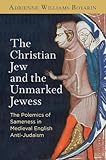The Christian Jew and the Unmarked Jewess : The Polemics of Sameness in Medieval English Anti-Judaism / Adrienne Williams Boyarin.
Material type: TextSeries: The Middle Ages SeriesPublisher: Philadelphia : University of Pennsylvania Press, [2020]Copyright date: ©2021Description: 1 online resource (352 p.) : 12 illusContent type:
TextSeries: The Middle Ages SeriesPublisher: Philadelphia : University of Pennsylvania Press, [2020]Copyright date: ©2021Description: 1 online resource (352 p.) : 12 illusContent type: - 9780812297508
- 305.8924041 23
- DS146.G7 .W555 2021
- online - DeGruyter
| Item type | Current library | Call number | URL | Status | Notes | Barcode | |
|---|---|---|---|---|---|---|---|
 eBook
eBook
|
Biblioteca "Angelicum" Pont. Univ. S.Tommaso d'Aquino Nuvola online | online - DeGruyter (Browse shelf(Opens below)) | Online access | Not for loan (Accesso limitato) | Accesso per gli utenti autorizzati / Access for authorized users | (dgr)9780812297508 |
Browsing Biblioteca "Angelicum" Pont. Univ. S.Tommaso d'Aquino shelves, Shelving location: Nuvola online Close shelf browser (Hides shelf browser)
Frontmatter -- Contents -- List of Abbreviations -- A Note on the Text -- Introduction. Saming the Jew -- Part I. The Potential of Sameness -- Historiae. The Friar and the Foundling -- Chapter 1. The Same, but Not Quite -- Chapter 2. English “Jews” -- Part II. The Unmarked Jewess -- Historiae. The Convert and the Cleaner -- Chapter 3. Anglo- Jewish Women -- Chapter 4. Mothers and Cannibals -- Chapter 5. Figures of Uncertainty -- Conclusion. Sameness and Sympathy -- Appendix 1. Sampson Son of Samuel of Northampton -- Appendix 2. Jurnepin/Odard of Norwich -- Appendix 3. Alice the Convert of Worcester -- Appendix 4. The Jewess and the Priest -- Notes -- Bibliography -- Index -- Acknowledgments
restricted access online access with authorization star
http://purl.org/coar/access_right/c_16ec
In the Plea Rolls of the Exchequer of the Jews, Trinity Term 1277, Adrienne Williams Boyarin finds the case of one Sampson son of Samuel, a Jew of Northampton, arrested for impersonating a Franciscan friar and preaching false Christianity. He was sentenced to walk for three days through the centers of London, Canterbury, Oxford, Lincoln, and Northampton carrying the entrails and flayed skin of a calf and exposing his naked, circumcised body to onlookers. Sampson's crime and sentence, Williams Boyarin argues, suggest that he made a convincing friar—when clothed. Indeed, many English texts of this era struggle with the similarities of Jews and Christians, but especially of Jewish and Christian women. Unlike men, Jewish women did not typically wear specific identifying clothing, nor were they represented as physiognomically distinct. Williams Boyarin observes that both before and after the periods in which art historians note a consistent visual repertoire of villainy and difference around Jewish men, English authors highlight and exploit Jewish women's indistinguishability from Christians. Exploring what she calls a "polemics of sameness," she elucidates an essential part of the rhetoric employed by medieval anti-Jewish materials, which could assimilate the Jew into the Christian and, as a consequence, render the Jewess a dangerous but unseeable enemy or a sign of the always-convertible self.The Christian Jew and the Unmarked Jewess considers realities and fantasies of indistinguishability. It focuses on how medieval Christians could identify with Jews and even think of themselves as Jewish—positively or negatively, historically or figurally. Williams Boyarin identifies and explores polemics of sameness through a broad range of theological, historical, and literary works from medieval England before turning more specifically to stereotypes of Jewish women and the ways in which rhetorical strategies that blur the line between "saming" and "othering" reveal gendered habits of representation.
Mode of access: Internet via World Wide Web.
In English.
Description based on online resource; title from PDF title page (publisher's Web site, viewed 01. Dez 2022)









